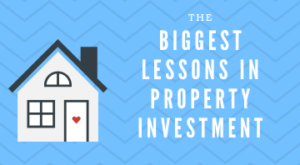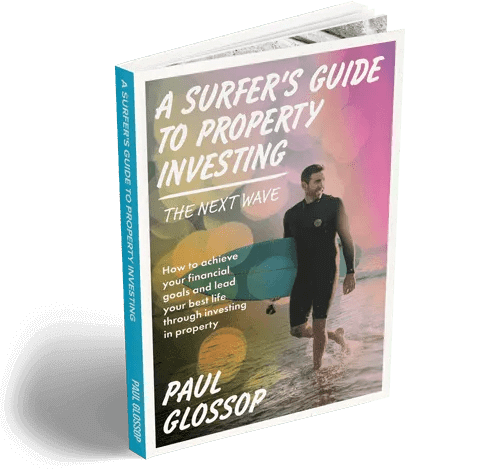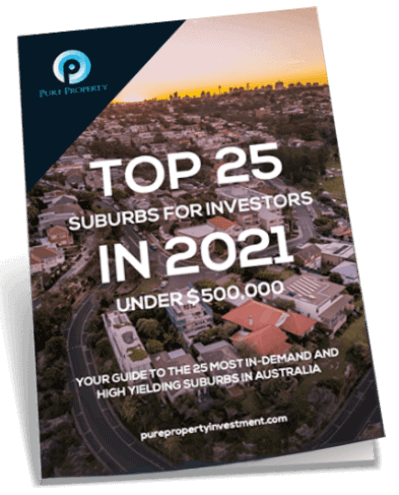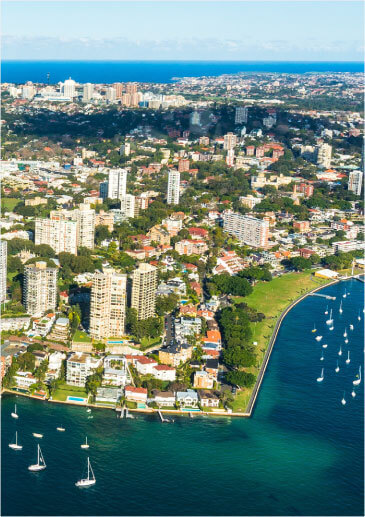South and north of the Sydney market where the opportunities are down from Wollongong, further down the south coast, central coast and Newcastle and beyond. They’re probably about 6 to 12, sometimes 18 months beyond where we are as cycle wise. You know Wollongong grew about five and a half percent. Newcastle grew about seven or eight percent last year or this past 12 months, but they’re on a downward trajectory, so I expect them to probably be with Sydney’s and about six to 12 months and they’ll probably be in that position longer than what Sydney will be because the jobs are still going to be focused around the Sydney CBD.
Changes In The Funding Environment And The Investor Approach
I think there’s a lot of property investors as well as potentially other property investment strategists who have had certain modus operandi over the last 10 years which worked in certain cases. But when you start to get a changing environment in funding and in growth and in yields, you can’t just keep running the same race because unfortunately the different competitor and you’ve got to change.
Capital Growth And Saving To Buy Back In Sydney
Very interesting question. I’ll reflect on my own journey when I sort of read something or hear something like that. Whereas my position, I started investing in my mid twenties and at the time Sydney was the market that I found opportunity in, um, as well as Melbourne given where obviously fast forwarding well over a decade from that point where the markets are for someone potentially with a restricted budget, with the intention longterm to come back into Sydney is a few things that I’d look at their probably the couple of the which is a capital growth opportunities be cashflow that’s going to allow you to hold that property and obviously see as the intention is I want to come back to the Sydney market to buy their home. I would look at it to say the question for me is yes, capital growth is, is obviously paramount, but then the other questions that what’s your ability to save?
Because if we’ve got a cohort of five, six, seven year timeframe between when you want to get back into Sydney, if you’re going to get put that deposit into a secondary market, whether it be Brisbane, whether it’d be Armadale, whether it be anywhere, you want to be able to make sure that you’re not necessarily restricting your ability to buy back in Sydney as you want to and, Secondly, I’d also want to make sure that part of that plan is to actually be able to retain that investment because if you’re planning to say, I want to invest and then, want to go and effectively pillage and take that money and then put it back into another market where I want to buy my home, chances are you’re not going to achieve either because you’re not going to get the capital growth. You’d expect the cycle you’d really want to be holding through.
It’d be, I’d say minimum 10, more like 10, 15 years mindset. However, if you’re not going to give it that time, you probably going to get a restricted amount of growth and always. Our rule of thumb is probably expect about nine percent of your total property value has to go up before you’ve made a penny in property. You’ve got stamp duty, cost entry, costs, exit costs, any kind of capital gains tax until you’ve made between eight and nine percent, you’ve effectively made no money, so I would say that to answer the question, make sure that you have really the right intention here to make sure that part of this investment is to hold it and the numbers are even if that property doesn’t go up in value, that you’re still saving money to come into Sydney, but then secondly, if you’re going to look at assessing markets that those markets are going to fit. Obviously your borrowing capacity, but b, are also going to allow you to continue to save in the background. So somewhat cashflow neutral. Not necessarily been the only focus, but capital growth is also going to be an overall disclaimer aside. That’s the overall achievement that needs to be needs to be hammered in.
The Two Biggest Lessons In Real Estate Investment
 When talking to first time investors there are multiple misconceptions to address and numerous lessons to teach.
I’m about to reveal the two biggest concepts that propel average real estate owners from being dabblers into forging a life where their free time isn’t eroded by earning a steady wage.
They are fundamental instructions that not everyone understands straight away. Really grasping onto these will ensure you can forge your path and stay the course – even when the challenges of property investment have you feeling like you might come undone, cut your losses and chuck it in.
These are the facets that will help you, ‘remember to breath’ (more about that later).
Lesson 1: Get rich slow
Talk to a group of buyers who were fortunate enough to acquire a good-quality holding in Sydney between 2009 and 2012.
Now, a percentage of those are experienced souls who have been at this game for a while. They’ve seen the ups, downs and sideward of the market and realise quick bursts of capital growth can be followed by extended periods of flat performance.
Unfortunately, among you the surveyed crowd, there will also be plenty of others for who this period of growth was their first. They’ll be applauding their ‘clever strategic approach’ and congratulating themselves on having superior research skills. These are usually first- or second-time landlords who got in at the right moment and have seen their property’s value rise by 50 per cent to 70 per cent in a short period. This crew is unfortunate because their psyche is now ingrained with the opinion that making money in real estate is both easy and fast.
Recent value gains in our biggest capital city have been extraordinary and profitable, but don’t for one minute believe they are the norm. Annual growth in the double digits is a brilliant thing if you buy early, but serious wealth comes from long term investing.
The dangers are real. I’ve heard of a number of investors without guidance who adopt the mantra “Buy, refinance, buy, refinance, buy, refinance…” with scant regards to their financial resilience, the market they’re in and the cycle stage it occupies. Markets turn (as you’ve no doubt noticed) and those who overextend their finance to keep riding this one-way ladder will find once they run out of rungs there is only a single way down – and it’s hard and fast.
In my experience, you must hold a property for an absolute minimum of ten years before you start to see established value growth… and this is a minimum.
Take a look at Brisbane. It’s a market with exceptionally good fundamentals including affordability and lifestyle, plus economic and population growth. Since 2008, Brisbane property has put in one of it’s least impressive decade-long performances in memory. During that time, there will have been those who speculated on a purchase only to sell within five years because the gains weren’t as good as Sydney or Melbourne. What an error to make.
Despite the perceived lukewarm market over those 10 years, Brisbane has seen median price growth of almost 40 per cent. While that may not sound extraordinary, it was during a time when a major flood event occurred, and the fallout of the post mining boom hit property prices.
So, despite the troubles, Brisbane investor who’ve waited are still well ahead … and best of all, the fundamentals look extraordinarily good for the next few years.
Lesson 2: Compound wealth
This is, without doubt, one of the single greatest financial lessons new investors can add to the quiver of learnings.
Compound growth builds phenomenal financial outcomes. There are two elements to remember here.
Firstly, by holding a property over the long term, you are effectively reinvesting the equity to build more value. Let’s use a simple, super-conservative example.
If you buy a property today for $500,000 in an area growing by a very modest average of five per cent a year, that doesn’t mean you will make $25,000 per year over the next ten years. Compound growth recognises that you will be ‘reinvesting’ that $25,000 from the first year so you will now be holding an asset worth $525,000 that will grow another five per cent in year two.
You now own an asset worth $551,240 that will grow again by five per cent. See where we’re going here? I’ve done the decade-long numbers for you.
If you were just making a five per cent non-compounded gain of $25,000 a year on your $500,000 investment, at the end of 10 years your holding is worth $750,000. But if you allow for the ‘reinvestment’ value of compounding, those same figures will see that asset be worth $814,447. That’s a compounding bonus of almost $65,000 in an underperforming market for doing very little.
The second element of compound growth is even better, because you add to that the boost of holding multiple properties AND being more strategic in your purchases. If you owned a portfolio valued at $3 million, and its compounding under the same modest rules above, in 10 years it will be worth $4,886,684 – an almost $1.9 million gain. That’s a pretty handy chunk of change.
Now imagine you are holding these properties through two or three of these cycles. The potential for upside is mind blowing. For well informed and highly diversified investors, there is also the chance to buy at the right stage in the cycle by not limiting yourself to one location but looking nationwide.
I realise there are variables and nuances in real life that need to be tackled, but for this exercise it’s important to be aware of why long-term strategic investment yields extraordinary results.
Why these lessons are crucial?
Armed with this knowledge, a savvy investor knows how to take a long-term view of their portfolio especially when things look dire. As I like to say… Remember to breath!
When you hit a bump in the road, stop, gather your thoughts and concentrate on the long game strategy. You are not in this for the short haul, but rather to reap the rewards in decades to come.
Markets rise slowly, growth compounds and, in the end if you stay the course, you will be looking back on your decision to remain in the game as one of the wisest moves of your life.
Just remember to breath.
Happy hunting.
When talking to first time investors there are multiple misconceptions to address and numerous lessons to teach.
I’m about to reveal the two biggest concepts that propel average real estate owners from being dabblers into forging a life where their free time isn’t eroded by earning a steady wage.
They are fundamental instructions that not everyone understands straight away. Really grasping onto these will ensure you can forge your path and stay the course – even when the challenges of property investment have you feeling like you might come undone, cut your losses and chuck it in.
These are the facets that will help you, ‘remember to breath’ (more about that later).
Lesson 1: Get rich slow
Talk to a group of buyers who were fortunate enough to acquire a good-quality holding in Sydney between 2009 and 2012.
Now, a percentage of those are experienced souls who have been at this game for a while. They’ve seen the ups, downs and sideward of the market and realise quick bursts of capital growth can be followed by extended periods of flat performance.
Unfortunately, among you the surveyed crowd, there will also be plenty of others for who this period of growth was their first. They’ll be applauding their ‘clever strategic approach’ and congratulating themselves on having superior research skills. These are usually first- or second-time landlords who got in at the right moment and have seen their property’s value rise by 50 per cent to 70 per cent in a short period. This crew is unfortunate because their psyche is now ingrained with the opinion that making money in real estate is both easy and fast.
Recent value gains in our biggest capital city have been extraordinary and profitable, but don’t for one minute believe they are the norm. Annual growth in the double digits is a brilliant thing if you buy early, but serious wealth comes from long term investing.
The dangers are real. I’ve heard of a number of investors without guidance who adopt the mantra “Buy, refinance, buy, refinance, buy, refinance…” with scant regards to their financial resilience, the market they’re in and the cycle stage it occupies. Markets turn (as you’ve no doubt noticed) and those who overextend their finance to keep riding this one-way ladder will find once they run out of rungs there is only a single way down – and it’s hard and fast.
In my experience, you must hold a property for an absolute minimum of ten years before you start to see established value growth… and this is a minimum.
Take a look at Brisbane. It’s a market with exceptionally good fundamentals including affordability and lifestyle, plus economic and population growth. Since 2008, Brisbane property has put in one of it’s least impressive decade-long performances in memory. During that time, there will have been those who speculated on a purchase only to sell within five years because the gains weren’t as good as Sydney or Melbourne. What an error to make.
Despite the perceived lukewarm market over those 10 years, Brisbane has seen median price growth of almost 40 per cent. While that may not sound extraordinary, it was during a time when a major flood event occurred, and the fallout of the post mining boom hit property prices.
So, despite the troubles, Brisbane investor who’ve waited are still well ahead … and best of all, the fundamentals look extraordinarily good for the next few years.
Lesson 2: Compound wealth
This is, without doubt, one of the single greatest financial lessons new investors can add to the quiver of learnings.
Compound growth builds phenomenal financial outcomes. There are two elements to remember here.
Firstly, by holding a property over the long term, you are effectively reinvesting the equity to build more value. Let’s use a simple, super-conservative example.
If you buy a property today for $500,000 in an area growing by a very modest average of five per cent a year, that doesn’t mean you will make $25,000 per year over the next ten years. Compound growth recognises that you will be ‘reinvesting’ that $25,000 from the first year so you will now be holding an asset worth $525,000 that will grow another five per cent in year two.
You now own an asset worth $551,240 that will grow again by five per cent. See where we’re going here? I’ve done the decade-long numbers for you.
If you were just making a five per cent non-compounded gain of $25,000 a year on your $500,000 investment, at the end of 10 years your holding is worth $750,000. But if you allow for the ‘reinvestment’ value of compounding, those same figures will see that asset be worth $814,447. That’s a compounding bonus of almost $65,000 in an underperforming market for doing very little.
The second element of compound growth is even better, because you add to that the boost of holding multiple properties AND being more strategic in your purchases. If you owned a portfolio valued at $3 million, and its compounding under the same modest rules above, in 10 years it will be worth $4,886,684 – an almost $1.9 million gain. That’s a pretty handy chunk of change.
Now imagine you are holding these properties through two or three of these cycles. The potential for upside is mind blowing. For well informed and highly diversified investors, there is also the chance to buy at the right stage in the cycle by not limiting yourself to one location but looking nationwide.
I realise there are variables and nuances in real life that need to be tackled, but for this exercise it’s important to be aware of why long-term strategic investment yields extraordinary results.
Why these lessons are crucial?
Armed with this knowledge, a savvy investor knows how to take a long-term view of their portfolio especially when things look dire. As I like to say… Remember to breath!
When you hit a bump in the road, stop, gather your thoughts and concentrate on the long game strategy. You are not in this for the short haul, but rather to reap the rewards in decades to come.
Markets rise slowly, growth compounds and, in the end if you stay the course, you will be looking back on your decision to remain in the game as one of the wisest moves of your life.
Just remember to breath.
Happy hunting.What Are The Pros & Cons Of Buying New
Host: Those pitfalls are.
Paul: Yeah. I mean long and short of it is the unforeseen. I’m building some properties myself at the moment and going through a whole list of what they deem to be PC items and fixed price contracts not of this fixed price contract so even if you are buying off the plan on a particular fixed contract price, there are so many additional aspects to that that as a first time buyer and/or owner builder you potentially won’t know what the pitfalls are and the additional costs that come into the play. If you look at it on the flipside though from any kind of benefits from buying off the plan or buying new there are certain states and certain development companies who potentially might look at offering things such as stamp duty exemptions or certain discounts on certain aspects of the build cost, so depending on which market you’re buying in there are certain times or certain opportunities where you can actually manufacture a bit of leverage and actually use that to a strength rather than a weakness, but it’s full of certain pitfalls if you’re not aware of what you’re looking for.
Host: Just looks like a pretty stressful way to buy given it you know the figures we’re looking at the beginning of this show it’s like units in Baulkham Hills, have gone down 19 percent. I mean if you bought one of those off the plan and then only had it for a couple of years and then it’s gone down by that much you’ve lost a lot of time when you were never even in the unit it was just sort of a line on a piece of paper.
Paul: Absolutely and that’s probably the really the biggest risk aspect of that off the plan component is typically off the plant doesn’t mean that two months later you own the property typically it’s somewhere between 12 and 36 months and in that time you’re looking consistently at data trying to think it is my property going up in value? Is it going sideways? Am I going to need to tip in a bigger deposit by settlement time comes around and quite frankly right now probably be bought off the plan in Sydney or Melbourne probably one or two years ago and looking at all three of those things happening at the same time. So definitely buying existing mitigates a lot of those risks because you buy existing products with existing rents existing markets and you can predict those outcomes a lot more specifically.






